Hello!
Today I want to give you information and my thoughts about elegance and elegant garments. In the first part we'll talk rather about the latter. Without useless fuss, let's start:
Suit
Suit - well-known and well loved. Probably everyone has worn it at least one time. Nowadays it's used frequently - for a wedding, work, etc. I think you know how the suit looks alike, and even if not, simply turn on your TV and at the next information service look at some politician or even announcer, but just in case I'll show you a photo of a gentleman in classic suit with almost all possible components:

Let's get to the point: a suit is composed of three pieces: trousers, jacket and waistcoat, the two-piece model lacks the last. All of the components are the same colour, nowadays there are also waistcoats matching the tie, hence they are similiar to a tuxedo. The shirt is usually white, with turndown collar. The suit jacket can be single- or double-breasted. A pocket square is often placed in the breast pocket. In jacket lapel there is a hole called boutonniere or buttonhole - at the special occasions, like wedding, a flower is put there. The neckwear is almost always necktie. However, sometimes a suit with a bowtie can be seen.
Proper shoes for a suit are black or brown shoes (can be patent leather) or only black slippers. Very elegant and relaxed is a white suit with white shoes - it can be an official summer dress. Besides black and white, suits are sewn in all colours.
All suits are appropriate for suit, but fedora and bowler are the most common choices.
Stresemann
Stresemann, also known as stroller (there is some difference, but we'll talk about it later) is undoubtely the least common official garment. It's, one can say, a transitional form of suit (which we were already talking about) and morning dress (which we will be talking about in a moment). Virtually, it's a morning dress with suit jacket.
It's composed of black or gray jacket, bright gray waistcoat and black and gray striped trousers without cuffs. The shirt is white, the collar was originally winged, like in white tie, later it was replaced by turndown, like in suit. A silver tie with an obligatory tie clip (a dark bow tie is also acceptable) and black shoes (not patent leather). It's a daytime dress, so it can be worn not later than 4-6 P.M. Stresemann was introduced by Gustav Stresemann, German chancellor. He pleaded for German politicians' case, who had to change their clothes while moving from office to Reichstag, where morning dress was worn.
Now what differs stresemann and stroller: stroller can have single- or double-breasted jacket, while stresemann must have single-breasted one (one button). So we can conclude that every stresemann is a stroller, but not every stroller is a stresemann. I hope you understand. :)
Homburg or bowler hat is best paired with stresemann.
Hey, a photo:
 Morning dress
Morning dress
Morning dress is the most elegant daytime garment.
It's composed of characteristic coat called "cutaway" (a pocket square is placed in the breast pocket), black or gray, gray waistcoat, black and gray striped trousers, white shirt (can be with turndown collar, winged collar or high detachable standing collar) and black shoes (not patent leather). A gray ascot or necktie is worn with it. Morning coat is distinguished by long, diagonal cut away quarters, which reach knees at the back. It's fastened only by one button, which is also its hallmark.
Morning dress is often mistaken with white tie and frock coat.
A proper hat with morning dress is a felt top hat - black or gray. A cane is also an elegant addition. :)
A photo (actually a illustration):
 Tuxedo
Tuxedo
Tuxedo is an elegant evening dress (so it can be worn after 4 P.M., there are also exceptions), very popular in North America. It's worn there for concerts, weddings, etc. :)
It's composed of single- or double-breasted jacket with silk lapels (nowadays often in shawl shape), trousers with single, black silk stripes along seams, without cuffs, waistcoat or cummerbund (lack when the jacket is double-breasted), white shirt with wing collar (like for white tie) and bow tie matching waistcoat or cummerbund. The single-breasted jacket always have got one button, like morning coat. Black shoes or slippers are worn with tuxedo (can be patent leather). The proper hat is Homburg, straw boater is appropriate in summer.
Tuxedo can be black or midnight blue. On warmer days white or ecru jacket is worn. A particular shirt for tuxedo has got golden buttons with black middle, they can't be regular, white. Cuffs are double (French). Black bow tie and waistcoat/cummerbund are obligation for diplomats, if we aren't them we can wear bow tie and waistcoat/cummerbund in another colour.
Tuxedo was invented by the Prince of Sutherland, who presented it on meeting in Carlton Club in 1889.
I almost forgot, a photo:
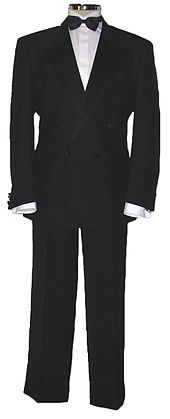 Frock coat
Frock coat
Frock coat is an elegant daytime dress. It was popularly worn in England at the turn of the century, nowadays it appears rarely, predominatingly on weddings.
It's composed of black waistcoat, single- or double breasted frock coat, white shirt with detachable standing collar, ascot and striped trousers. Later the standing collar was replaced with winged and ascot was replaced with necktie. There is also a special overcoat for frock coat, which covers its quarters. Shoes like in morning dress. For official occasions a black top hat is worn, for other occasions usual headgear is bowler or Homburg. Like for morning dress, a cane is often carried with frock coat.
 White tie
White tie
White tie, also called tails, is the most elegant evening dress. It's frequently worn by conductors and monarchs on miscellaneous ceremonies. Sometimes it can be seen as a wedding attire.
It's composed of black, double-breasted tailcoat with long tails at the back, white waistcoat, white bow tie, black trousers with stripes on seams, white shirt with wing collar and black patent leather shoes.
It should be mentioned, that the white tie with black waistcoat is a daytime dress. Coat lapels are faced in satin. Coat should never be fastened!
A black bow tie never should be worn with bow tie - waiters in elegant restaurants do it, so we can be mistaken for them. :) Some musicians wear white cummerbunds instead of waistcoats, like for tuxedo, I think it's rather extravagant.
If we want to "go the whole way" and dress the most elegant as it only can be, add to the white tie black opera hat (collapsible top hat), white gloves, white satin scarf, black silk cloak and a black cane with white ball.

When it comes to accesories:
-watch - if we wear a wristwatch, colour of the band should be suitable for the colour of the suit. More elegant is, however, a pocket watch with golden or silver watch chain. Such a watch is carried in a pocket of waistcoat and the second end of the chain is attached to the button. If we go on some official ceremony and we haven't got a pocket watch, better don't take any watch.
-winter mantle - black, grey or navy overcoat, the most elegant and adequate is Chesterfield. For cold days we may need a deerstalker hat: the one that Sherlock Holmes worn. :)
A few details also should be remembered: the last button of a jacket and waistcoat should be unfastened (except when there's only one button of course :) ), trousers should always be worn with suspenders, at least 1,5 centimeters of shirt cuff should be seen, etc. :) If you have got any questions, ask me or search on Internet. :P
Best regards, Dr
P.S. On statistics I've seen a lot of people read this article - so welcome to its improved, supplemented and revised version
here.
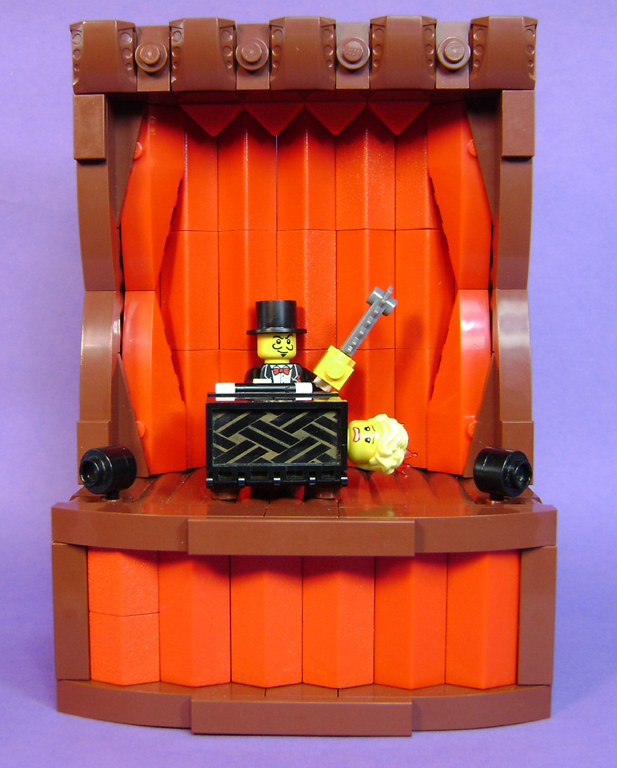









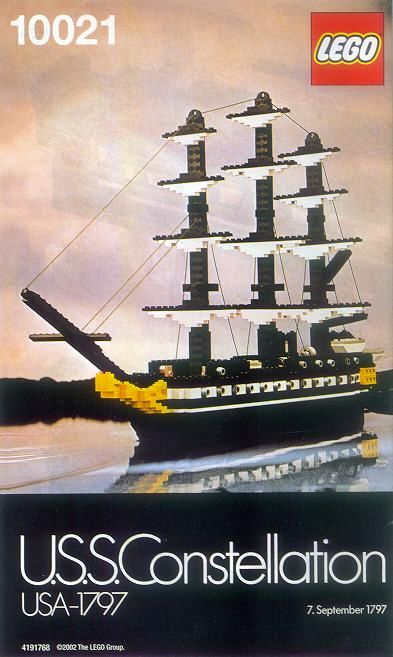
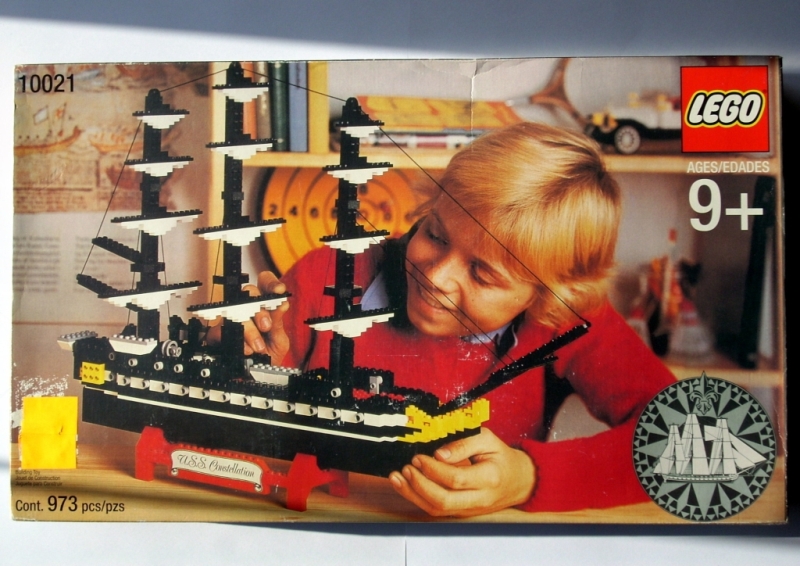
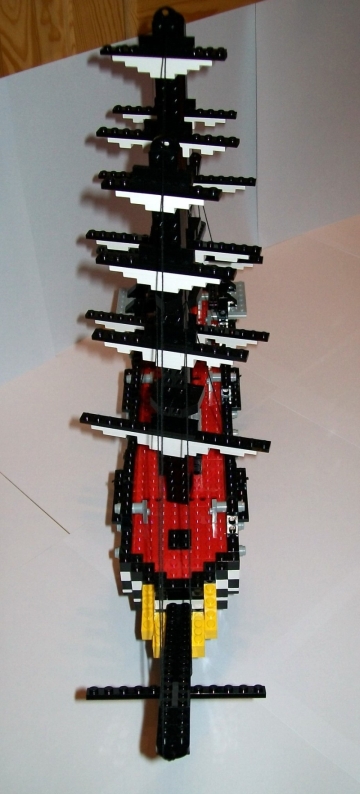
 apple - appears in following colours: BrightGreen, Green and Red. Not so rare, usually costs less than one dollar.
apple - appears in following colours: BrightGreen, Green and Red. Not so rare, usually costs less than one dollar.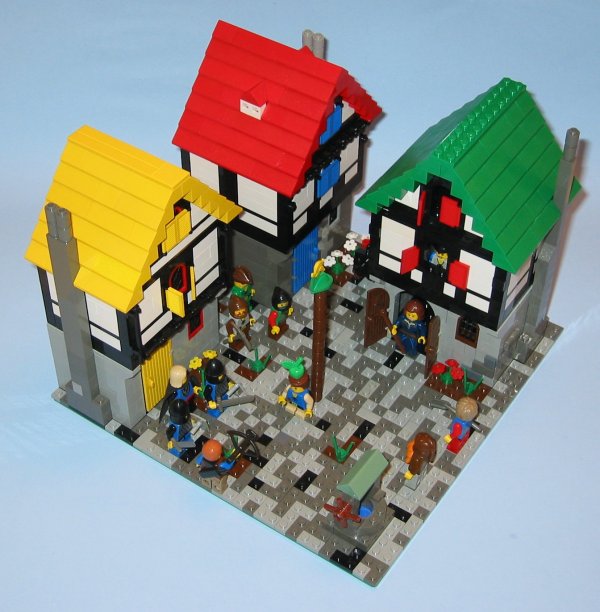
 banana - oficially it appears in tan and yellow, but only the latter part can be considered as food, because the tan one was used in Harry Potter set 4767 as a dragon's claw. Hence it, the common yellow part is cheap, and rarer more expensive - costs somewhere around one dollar.
banana - oficially it appears in tan and yellow, but only the latter part can be considered as food, because the tan one was used in Harry Potter set 4767 as a dragon's claw. Hence it, the common yellow part is cheap, and rarer more expensive - costs somewhere around one dollar. bread (IMO more similiar to baguette) - undoubtely rarer than apples or bananas - appears in 13 sets, in addition only in Fabuland and Belville themes. Appears in three colours: Earth Orange, Light Yellow and Tan. Costs average about 2 dollars. This part is very useful especially in building bakeries, like this, by Hippotam:
bread (IMO more similiar to baguette) - undoubtely rarer than apples or bananas - appears in 13 sets, in addition only in Fabuland and Belville themes. Appears in three colours: Earth Orange, Light Yellow and Tan. Costs average about 2 dollars. This part is very useful especially in building bakeries, like this, by Hippotam:


 Belville cakes - rare, perhaps because they appear only in Belville sets. The price of this one in the middle is 7 dollars! When summarize, they appear in 11 sets. Parts useful for all kinds of parties, banquets etc.
Belville cakes - rare, perhaps because they appear only in Belville sets. The price of this one in the middle is 7 dollars! When summarize, they appear in 11 sets. Parts useful for all kinds of parties, banquets etc.
 carrot - nothing special, except it's composed of two parts. The price rather doesn't exceed one dollar. This part, like the most of food parts, has its roots in Belville theme, and then it was moved to minifig themes. This explains the carrot's monstrous size, that in terms of our sizes measures about 1,5 meters long. Polish master of vignette, Crises, has built this small work, showing dwarves guarding carrots, which are pulling by a rabbit:
carrot - nothing special, except it's composed of two parts. The price rather doesn't exceed one dollar. This part, like the most of food parts, has its roots in Belville theme, and then it was moved to minifig themes. This explains the carrot's monstrous size, that in terms of our sizes measures about 1,5 meters long. Polish master of vignette, Crises, has built this small work, showing dwarves guarding carrots, which are pulling by a rabbit:
 cherries - probably the most common Lego food, they usually appear in sets in amount of few pieces. Expect DarkPink and red, they also appear in Lime, which isn't suitable for cherries. I think they are chestnuts. :) They cost less than 15 cents. A builder which hides under a strange nick borda has built nice vignette showing a cherry-tree:
cherries - probably the most common Lego food, they usually appear in sets in amount of few pieces. Expect DarkPink and red, they also appear in Lime, which isn't suitable for cherries. I think they are chestnuts. :) They cost less than 15 cents. A builder which hides under a strange nick borda has built nice vignette showing a cherry-tree:
 croissant. Well, real croissants are made out of French pastry, without filling, eaten by Frenchmen for breakfast, but it's not a culinary blog, so let's call it a croissant. Very interesting and useful part, it is useful not only for bakeries, but also for elegant restaurants and some romantic French pubs (the best in CCC tenements). I saw it once used as a stomach, but never mind. They were released in two types - more and less baked, or Dark Orange and Earth Orange. On the vignette showed below we can see a Frenchmen eating his breakfast. Maybe he isn't very similiar to a Frenchmen, but let it be:
croissant. Well, real croissants are made out of French pastry, without filling, eaten by Frenchmen for breakfast, but it's not a culinary blog, so let's call it a croissant. Very interesting and useful part, it is useful not only for bakeries, but also for elegant restaurants and some romantic French pubs (the best in CCC tenements). I saw it once used as a stomach, but never mind. They were released in two types - more and less baked, or Dark Orange and Earth Orange. On the vignette showed below we can see a Frenchmen eating his breakfast. Maybe he isn't very similiar to a Frenchmen, but let it be: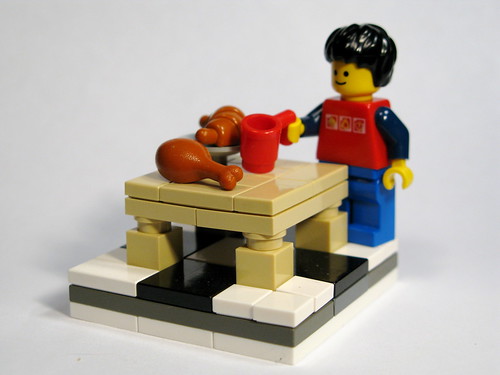
 on Bricklink it appears as Hot Dog, but I'll call it a sausage. Well, sausage - rather useful part as the Lego meat arsenal isn't very substantial. Summarizing, there's nothing more that can be said about it. It appears in red and Flesh, or this like flesh of Arabs from Indiana Jones. I haven't find any interesting work with sausages, if someone of you have seen it, give me the link please. ;)
on Bricklink it appears as Hot Dog, but I'll call it a sausage. Well, sausage - rather useful part as the Lego meat arsenal isn't very substantial. Summarizing, there's nothing more that can be said about it. It appears in red and Flesh, or this like flesh of Arabs from Indiana Jones. I haven't find any interesting work with sausages, if someone of you have seen it, give me the link please. ;) ice cream - well, one of the rarest parts in this category. This part hardly appears in any MOCs, I haven't seen any, at least. If someone has seen it, give me the link, please. :) A brick appears in three colours - yellow, white and Medium Orange, this last appears only in one set, Belville in addition.
ice cream - well, one of the rarest parts in this category. This part hardly appears in any MOCs, I haven't seen any, at least. If someone has seen it, give me the link, please. :) A brick appears in three colours - yellow, white and Medium Orange, this last appears only in one set, Belville in addition. the next ice cream, but now it's a lot more common part, appears in MOCs frequently, and what's the most important, it can be seen in sets, which aren't Belville. :) They were produced in six, not frequently seen colours, the rarest are Salmon and Light Green (5$). White cost only about 40 cents, however. One MOC with this kind of ice cream has fallen into my eye - a weird vehicle builded by certain døver, which I have probably already seen somewhere:
the next ice cream, but now it's a lot more common part, appears in MOCs frequently, and what's the most important, it can be seen in sets, which aren't Belville. :) They were produced in six, not frequently seen colours, the rarest are Salmon and Light Green (5$). White cost only about 40 cents, however. One MOC with this kind of ice cream has fallen into my eye - a weird vehicle builded by certain døver, which I have probably already seen somewhere: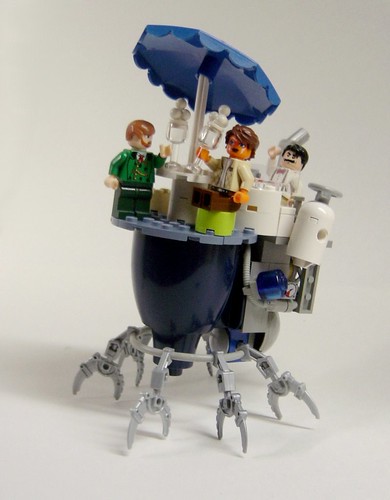
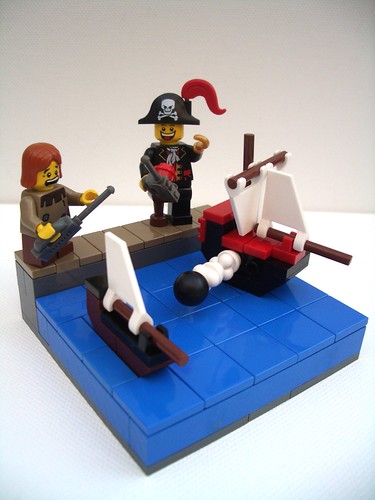
 muffin. Well, it isn't very interesting or rare part. Altough it costs one and a half dollars, which gives it a place higher than eg. an apple or a cherry, but it isn't any white raven. It rarely appears in MOCs, like the most of Belville parts. However it's interesting that it's simply a cook's hat with a print.
muffin. Well, it isn't very interesting or rare part. Altough it costs one and a half dollars, which gives it a place higher than eg. an apple or a cherry, but it isn't any white raven. It rarely appears in MOCs, like the most of Belville parts. However it's interesting that it's simply a cook's hat with a print. next ice cream. Now they are ice jolly, however. They appear in six colours, but only brown and red are rare (more than one dollar). I can't tell nothing more about it. I like PipCasbar's work, showing R2-D2 selling ice cream:
next ice cream. Now they are ice jolly, however. They appear in six colours, but only brown and red are rare (more than one dollar). I can't tell nothing more about it. I like PipCasbar's work, showing R2-D2 selling ice cream: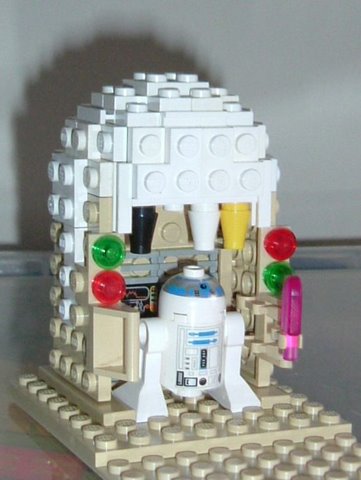
 turkey. An obligatory part of all kinds of banquets and feasts. It appears in two colours: Dark Orange (which costs about 3,30 dollars) and Earth Orange, which costs even 16 dollars! This is a real white raven! :) It's such a legendary part, so it appears in lots of MOCs, but I'll show only one, which I liked the most, by marakoeschtra:
turkey. An obligatory part of all kinds of banquets and feasts. It appears in two colours: Dark Orange (which costs about 3,30 dollars) and Earth Orange, which costs even 16 dollars! This is a real white raven! :) It's such a legendary part, so it appears in lots of MOCs, but I'll show only one, which I liked the most, by marakoeschtra: